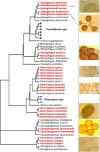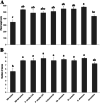From isolation to application: a case study of arbuscular mycorrhizal fungi of the Arabian Peninsula
- PMID: 35368327
- PMCID: PMC8933382
- DOI: 10.1007/s13199-021-00824-x
From isolation to application: a case study of arbuscular mycorrhizal fungi of the Arabian Peninsula
Abstract
The vegetation in the Arabian Peninsula experiences drought, heat, soil salinity, and low fertility, mainly due to low phosphorus (P) availability. The beneficial mycorrhizal symbiosis between plants and arbuscular mycorrhizal fungi (AMF) is a key factor supporting plant growth under such environmental conditions. Therefore, AMF strains isolated from these soils might be useful as biotechnological tools for agriculture and revegetation practices in the region. Here we present a pioneering program to isolate, identify, and apply AMF isolated from rhizosphere soils of agricultural and natural habitats, namely date palm plantations and five native desert plants, respectively in the Southern Arabian Peninsula. We established taxonomically unique AMF species as single-spore cultures as part of an expanding collection of AMF strains adapted to arid ecosystems. Preliminary experiments were conducted to evaluate the abilities of these AMF strains to promote seedling growth of a main crop Phoenix dactylifera L. and a common plant Prosopis cineraria L. (Druce) in the Arabian Peninsula. The results showed that inoculation with certain AMF species enhanced the growth of both plants, highlighting the potential of these fungi as part of sustainable land use practices in this region.
Keywords: Date palm; Desert ecosystem; Mycorrhizal symbiosis; Native plants; Oman.
© The Author(s) 2021.
Conflict of interest statement
Conflicts of interest/competing interests The authors declare that they have no conflict of interest.
Figures




References
-
- Al-Shahib W, Marshall RJ. The fruit of the date palm: its possible use as the best food for the future? Int J Food Sci Nutr. 2003;54(4):247–259. - PubMed
-
- Anli M, Symanczik S, El Abbassi A, et al. Use of arbuscular mycorrhizal fungus Rhizoglomus irregulare and compost to improve growth and physiological responses of Phoenix dactylifera ‘Boufgouss’. Plant Biosyst. 2020;155(4):763–771.
-
- Antunes PM, Koch AM, Morton JB, et al. Evidence for functional divergence in arbuscular mycorrhizal fungi from contrasting climatic origins. New Phytol. 2011;189(2):507–514. - PubMed
LinkOut - more resources
Full Text Sources
